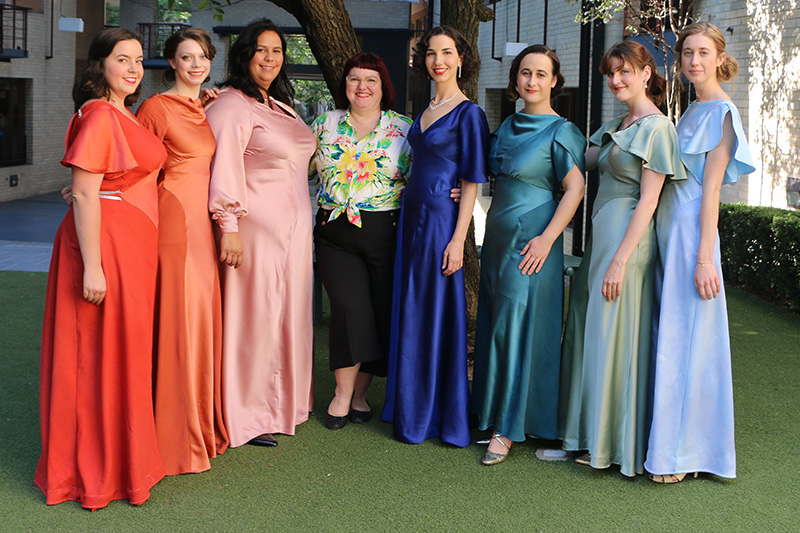NIDA Costume students showed off the results of their work with Beryl Waldron, Senior Ladies Cutter at Opera Australia, creating evening dresses from the 1930s.

Beryl Waldron (centre) with NIDA second-year Bachelor of Fine Arts (Costume) students, from left to right: Sarah Murdoch, Avril Bradbury-Hoath, Emily Pires, Tess Healy, Siobhan Nealon, Alloquois Callaway and Georgia Attewell-Moore.
NIDA Costume students showed off the results of their work with Beryl Waldron, Senior Ladies Cutter at Opera Australia, creating evening dresses from the 1930s.
Beryl is a guest costume tutor at NIDA, and loves to share her outstanding industry experience and knowledge with the students. She worked with NIDA’s second-year Bachelor of Fine Arts (Costume) students to design and make a dress that would be appropriate for a young woman in Sydney to wear to an evening at the iconic State Theatre in the early 1930s. The dresses had to be modest, with sleeves and to the floor, as the young women were travelling unchaperoned.
The results are stunning, bringing the flowing and glamorous 1930s to life and capturing a unique time in women’s fashion. Gone were the flapper styles of the 1920s, and in came a more elegant and slender look, with film stars Greta Garbo and Marlene Dietrich capturing its essence.
Beryl explained what is unique about the dresses of the period. ‘The 1930s look is about soft silhouettes and natural. This project is about utilising the stretch and movement in the fabric by cutting it on a 45-degree angle, called a bias cut. This popular cut created a pliability in the fabric. Rayon was often used, and silks or sometimes lurex.’
‘Until now the students have been learning about straight grain and how to manipulate that,’ she explained. ‘For a 1930s bias-cut you throw that rule book out of the window.’
Student Emily Pires explained that learning about how to create a bias-cut dress brings certain challenges, as the fabric stretches and hangs in a unique way. ‘Added to that, the fabric drops over time so you have to let it hang for at least 24 hours before you work on it,’ said Emily. The project included fabric dyeing, with each student choosing the design and colour of the dresses based on research.
Emily’s next task is to work with third-year Bachelor of Fine Arts (Design for Performance) student Meiko Wong on the upcoming Festival of Emerging Artists. Emily is the Costumer Supervisor on Pagliacci, making and sourcing the costumes.
‘I’m really excited to be working on Pagliacci with sets, props and costume design by Meiko,’ she said. ‘We have two weeks to get the costumes together then we go into production. After the new year we are placed on secondment in the industry, then we return back to NIDA and start working on productions full time for our third year. It’s busy, but I’m really excited. I wouldn’t be doing anything else.’
Feeling inspired? For information about NIDA’s Bachelor of Fine Arts (Costume) course, visit apply.nida.edu.au.
The Festival of Emerging Artists, generously supported by the Nick Enright Literary Estate, opens on Wednesday 11 December and runs until Saturday 14 December with all shows running every night from 7�9pm across three NIDA Theatres. Visit here to buy tickets.

